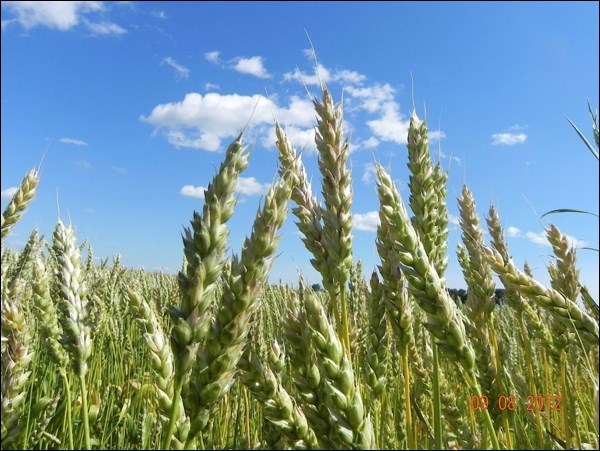Early frost can be detrimental to crops especially if the development has been delayed. The extent of damage caused by frost depends on the temperature, length of exposure time, humidity levels and the speed to which the freezing temperature was reached. In order to understand the effects of frost one must understand plant cells. Plant cells contain not only water but also many substances such as proteins, sugars, amino acids and other solutes that can lower the freezing temperature and protect the cells against intracellular ice formation (similar to antifreeze in your car). What this means is that even though water freezes at 0 C a plant cell may need temperatures down to -4 C or lower before the cells will freeze and damage occurs. Different parts of the plant, different stages of development of the plant, and different types of plants can have varying levels of these 'antifreeze' compounds that result in a range of susceptibility to frost.
Environmental conditions such as drought, cold temperatures, heat, etc., can also influence the levels of these compounds, and thus affect the tolerance to freezing temperatures. Typically, when a plant is exposed to stress they become more hardened which can moderately increase the tolerance to frost. Frost damage occurs as moisture within the plant crystallizes and expands. This causes cell walls to rupture and fluid to leak out thus, the watery appearance of plant tissue or seed after a damaging frost.
Spring frosts can damage germinating seedlings and the extent of damage will depend on the location of the growing point (above or below ground) and the level of anti-freeze properties contained within the plant. Exposure to cooler temperatures over time can harden off plants so that they are more tolerant to frost. A gradual change in temperature has a lesser effect than a dramatic change in temperature. Plants are able to resist injury if the temperature changes are gradual or are only encountered for a short period of time.
Environmental conditions also play a role in crop tolerance to spring frost. Dry soil conditions, high wind with high evaporation potential aggravate frost injury. Moist soils or heavy dews can reduce the injury.
Plants that have been hardened can survive lower temperatures than plants that have not been hardened. Cool conditions for a few days prior to a frost will help harden the crop. Plants can lose their hardened condition and improved tolerance to frost after exposure to warm temperatures and good growing conditions. Plants that are growing rapidly are damaged more by frost in comparison to those that are growing slowly. Other stresses that cause the plants to grow slowly can help harden the plants and protect them from frost damage.
The growing point of cereals is below ground until approximately the five leaf or jointing stage. This protects the plant from severe frost injury in the spring. The plants may lose above ground leaf matter but will re-grow from below ground. Partial injury can be seen when the tips of leaves or leaf edge become damaged, yellow and then burn brown and brittle. Severe injury to cereals where all above ground matter is damaged can result in a delay in maturity due to the plant having to re-grow.
Flax is quite sensitive to frost when it is coming out of the ground. Temperatures of -2 C can injure flax up to the two leaf stage. As flax grows it becomes more tolerant to frost. After the two leaf stage flax can withstand temperatures down to -7 C and even slightly lower if the plants have been hardened.
Frost canker can be a problem with flax during early stages of growth and can reduce stands by as much as 50 per cent. Damage is most severe in thin stands on light soils and in low spots. Symptoms of frost canker are similar to heat canker. There will be plants or areas in the field where the plants have toppled over. At or near the soil surface the plants will be girdled and have constricted stems.
Newly emerged canola at the cotyledon stage can be very susceptible to spring frosts. The growing point is above ground between the cotyledons. Plants at the three to four leaf stage are much more tolerant and can withstand a couple more degrees of frost. A light frost that burns the leaves may not injure the growing point of canola. If there is re-growth or green material at the growing point then the plants should recover. It will take a few days to really assess the damage and green growth should be visible after four to 10 days.
Peas and lentils have good frost tolerance. They have growing points (bracts) which remain below ground during early development. The above ground material may be severely injured by frost but new growth will resume from the bracts and will appear approximately seven to 10 days after the frost.
Frost damage is very hard to predict as there are so many factors that affect the tolerance. Evaluating the damage is difficult and should be done approximately 24 to 48 hours after the frost for initial symptoms and up to a week to 10 days for full extent of damage. Be patient with cereals, peas and lentils as the crop will regrow from growing points below ground. With canola, the decision can be more tricky. Look for green color in the above ground growing point and watch for regrowth. Again patience is key.
For more information on this, or other crops related topics, contact Sherrilyn Phelps at 306-446-7475 or the Agriculture Knowledge Centre at 1-866-457-2377.



